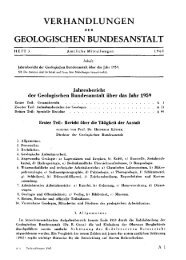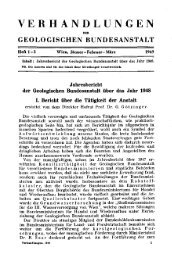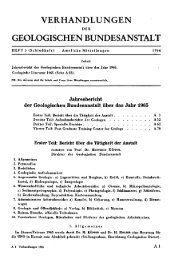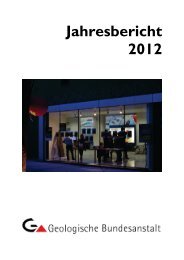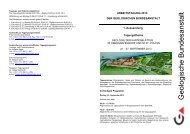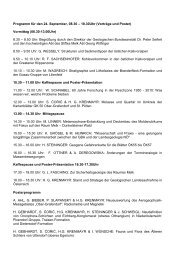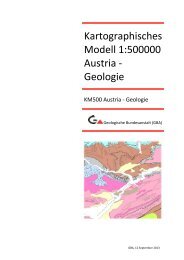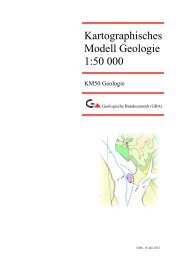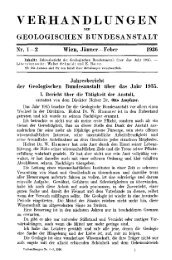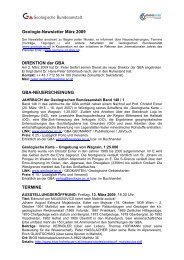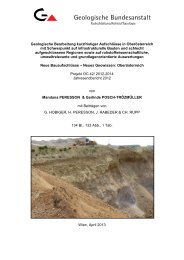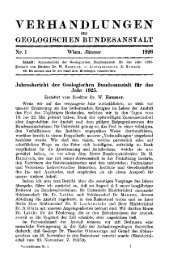Field Trip B TRIASSIC CONODONT LOCALITIES OF THE ...
Field Trip B TRIASSIC CONODONT LOCALITIES OF THE ...
Field Trip B TRIASSIC CONODONT LOCALITIES OF THE ...
You also want an ePaper? Increase the reach of your titles
YUMPU automatically turns print PDFs into web optimized ePapers that Google loves.
ocks is markedly sharp. The irregular and nodular bedding planes of the Hangendrotkalk are covered<br />
by thin iron-hydroxide crusts (subsolution pattern, see KRYSTYN et al. 1971 a). Samples so far collected<br />
have yielded platform conodonts the frequence of which varies from 50 to 100 specimens per kg.<br />
The fauna of the two lowermost samples 75/11 and 75/12 is dominated by specimens of-E. abneptis<br />
spatulata against rare occurrences of-E. abneptis abneptis, further E. postera, and Gondolella hallstattensis.<br />
The age of this assemblage is precisely determinable by the accompanying ammonites indicative<br />
of uppermost Lower Norian (Magnus Zone). The succeeding sample 75/13 contains the same platform<br />
conodonts except G. hallstattensis which is replaced by G. steinbergensis. This species has been found<br />
elsewhere, e. g., at Feuerkogel and in Timor, to range not lower than the base of the Bicrenatus Zone.<br />
Therefore a Middle Norian age is concluded for this fauna but this is not proved implicitly. The uppermost<br />
collected sample 75/14 contains a great number of£. a. abneptis together with rare.E. a. spatulata,<br />
E. postera and G. steinbergensis. Based on these conodonts the sample clearly can be assigned to the<br />
basal Middle Norian Bicrenatus Zone (lower postera-A. Z.).<br />
Section B is located at the western end of the Bicrenatus-Lager (p. IV in fig. 15). It is also composed<br />
of a 3 m thick sequence of Hangendrotkalk; 10 exposed beds have been* sampled. Conodont abundance<br />
varies considerably: Generally, the abundance is lower than in section A. Bed nos. 2, 3, 4 and 10 are<br />
rich in platform conodonts. Bed no. 1 forms a prominent and steep rock structure near p. IV with a<br />
small north directed base on which the section is located.<br />
Bed nos. 1 to 10 contain the following platform conodonts:<br />
age<br />
N bed 1: E. abneptis 1 x, E. postera 2 x, E. bidentata 4 x, G. steinbergensis 4 x.<br />
•4 bed 2: E. abneptis 19 x, E. postera 19 x, E. cf. bidentata 1 x, G. steinbergensis 45 x.<br />
,2 bed 3: E. abneptis 4'x,£. postera 6 x, G. steinbergensis 27 x.<br />
bed 4: E. postera 1 x, E. bidentata 3 x, G. steinbergensis 18 x.<br />
'SI . bed 7: G. steinbergensis 6 x.<br />
^ bed 10: E.abneptis 1 x, E. postera 2 x, E. bidentata 4 x, G. steinbergensis 4 x.<br />
Due to rich presence of the ammonoid genus Halorites in bed no. 4 samples 1 to 4 are tentatively dated<br />
as uppermost Middle Norian. The high content of E. abneptis and E. postera in sample no. 2 allows<br />
a more precise age determination of the two basal beds based on conodont evidence (see above). In the<br />
Upper Norian portion of section B (bed nos. 5—8) megafossils are extremely rare; the only exception<br />
is the occurrence of the hydrozoan genus Heterastridium. One specimen of Paracladiscites multilobatus<br />
(BRONN) was found in bed no. 8, also one questionable representative of the genus Rhabdoceras<br />
(a cross section). Bed no. 10 may be traced laterally over some 40 m representing there the typical Metternichi-Lager<br />
(locality 68/55). At Sommeraukogel it contains a rich Upper Norian ammonoid and conodont<br />
faunafE. postera 10 x, E. bidentata 95 x, G. steinbergensis 18 x).<br />
The last stop at Sommeraukogel is dedicated to the transition beds between the Hallstatt Lst. and<br />
the Zlambach Fm. (between p. VI and p. VII, see fig. 14). The transitional beds consist of two meters<br />
of red to greyish thin bedded nodular limestones with red marl intercalations. The following ramiform<br />
conodonts were found: Misikella hernsteini (MOSTLER), Oncodellapaucidentata (MOSTLER),<br />
Hindeodella suevica (TATGE), Neohindeodella triassica (MÜLLER), Hibardella magnidentata (TAT-<br />
GE), Prioniodina muelleri (TATGE). According to MOSTLER et al. 1978 also G. steinbergensis is represented<br />
but yet no other platform conodonts have been found. In terms of ammonoid stratigraphy<br />
these beds indicate a lowermost Rhaetian age (Stuerzenbaumi Subzone).<br />
DAY 3<br />
Koessen Beds of the Osterhorn mountains (Adnet region)<br />
(Rhaetian conodonts)<br />
The excursion will leave Hallstatt in northward direction via Trauntal to Bad Ischl and then turn<br />
westward to Salzburg. Close to the village Strobl at Lake Wolfgang the Zinkenbach will be crossed. One<br />
of the branches of Zinkenbach is Kendlbachgraben where Koessen Beds are well exposed along a forest<br />
track. This classical locality, however, seems unsuitable to obtain good reference material of Rhaetian<br />
conodonts due to its dominance of marls. Hence, another locality will be visited in the surroundings of<br />
Adnet near the small village of Gaissau, south of the city of Salzburg. The Gaissau section is situated<br />
about 10 km from Kendlbachgraben (fig. 16). The Koessen Beds exposed at either locality are lateral<br />
equivalents and part of the same tectonic unit. Both sections are easily comparable by their distinct li-<br />
93



